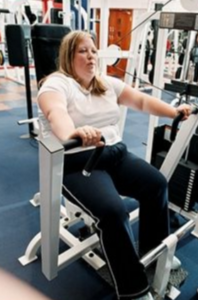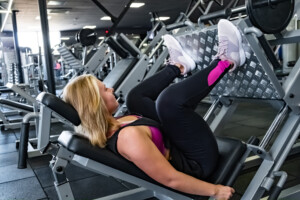
Are you very plus size and wondering if lifting weights can harm your joints, due to your obesity?
There are various exercises that plus size women and men do that are more threatening than lifting weights.Strength training is actually a lot safer for obese people than is running up stairs, stool stepping or jumping drills, which many personal trainers have their obese clients performing. There is a risk of stumbling.
“Lifting weights is important for all people, but obese people in particular,” says Jason Baynes, MD, a sports medicine orthopedic surgeon with Health East Medical Center in Englewood, NJ.
“Weight training will not only build strength but also increases metabolism — as the more toned a patient’s muscles are the more that muscle is metabolizing.
“Also, more muscular strength will decrease the amount of stress on the bones of a particular joint.”
The ironic thing about strength training is that if you’re obese, you’ve already been doing a lot of weightlifting, and I don’t mean this in an insulting sense, either.
In fact, a study led by researcher Tapio Videman of the University of Alberta’s Faculty of Rehabilitation Medicine, showed that there was less disc degeneration (back problems) among the heavier of identical twins studied, in which the heavier twin, on average, weighed 29 pounds more than the lighter twin.
In other words, the weight that the twins were lifting every day, and what the study examined, was their own body weight.
Obese people, in some respects, have a head start when it comes to lifting weights, since they are continuously lifting excess weight just by engaging in day-to-day activities.
However, this doesn’t mean that being obese is good for the joints.
Despite what Videman’s study found, it’s still a general consensus among healthcare professionals and personal trainers that obesity is harmful to back and knee joints.
Other Joints to Consider
These are the joints of the shoulder, elbow, wrists and upper back (scapula). When a very heavy person begins a strength training program, he or she is truly on an even playing field with smaller people.

Shutterstock/LightField Studios
I have witnessed this as a personal trainer. Many very overweight people do quite well with weightlifting, depending on the routine.
Though obesity is linked to joint (back and knee) problems, very plus-size people who are otherwise free of disease do well with pulling motions against resistance: lat pull-downs and rowing routines.
Rowing routines are when you are seated and pull handles towards you horizontally, beginning with arms outstretched in front, and bringing the load towards your chest (see below).

Shutterstock/Microgen
Obese people perform these exercises very well, but any-size person who is new to lifting weights should start out with light weights to acquaint their body to an unfamiliar exercise.
Obese people certainly do not risk wear and tear, or injury, to their joints by performing middle/upper back routines like lat pull-downs and rows.
Another safe joint weightlifting exercise is chest pressing, which can be done while seated and pushing resistance horizontally away from the chest (resistance machines), or while lying on one’s back and pushing the resistance upward away from the chest (bench pressing or dumbbell pressing).

Chest Press
The precautions that very heavy people should take are the same as what smaller individuals should take:
Novices should start out with light weights and high repetitions, to avoid straining shoulder tendons.
This is a general rule that applies to people of all sizes, and there is nothing intrinsic about being obese that precludes a person from performing chest and back strength training.
Cause of Strength Training Injuries: Overuse or Poor Form, not Obesity
Though there are several strength training moves that I’d never endorse for a very obese individual, such as dips, pushups and deep walking lunges — the overall picture is very promising as far as a strength training regimen.
The leading causes of injuries when training with weights are overuse and poor form — which can affect thin people as much as plus size.
Obese people can also perform well with leg pressing, leg extension and leg curl motions, though my advice is to go easy at first (especially with pressing/extension) — not because of the obesity, but because of a general rule with these types of exercises.

Shutterstock/Aleksey Boyko
Strength training is a safe route for obese people to take, provided that they start out conservatively to acquaint their bodies with something new; use correct form; don’t overdo it; and choose no-nonsense, basic strength training routines for the major muscle groups.
Many weight lifting exercises are performed while seated, and strength training machines provide neutral spinal alignment.
 In addition to being an on-field physician for many high school football teams, Dr. Baynes has been a team physician for a wide array of professional and collegiate sports teams.
In addition to being an on-field physician for many high school football teams, Dr. Baynes has been a team physician for a wide array of professional and collegiate sports teams.
 Lorra Garrick is a former personal trainer certified through the American Council on Exercise. At Bally Total Fitness she trained women and men of all ages for fat loss, muscle building, fitness and improved health.
Lorra Garrick is a former personal trainer certified through the American Council on Exercise. At Bally Total Fitness she trained women and men of all ages for fat loss, muscle building, fitness and improved health.
.

























